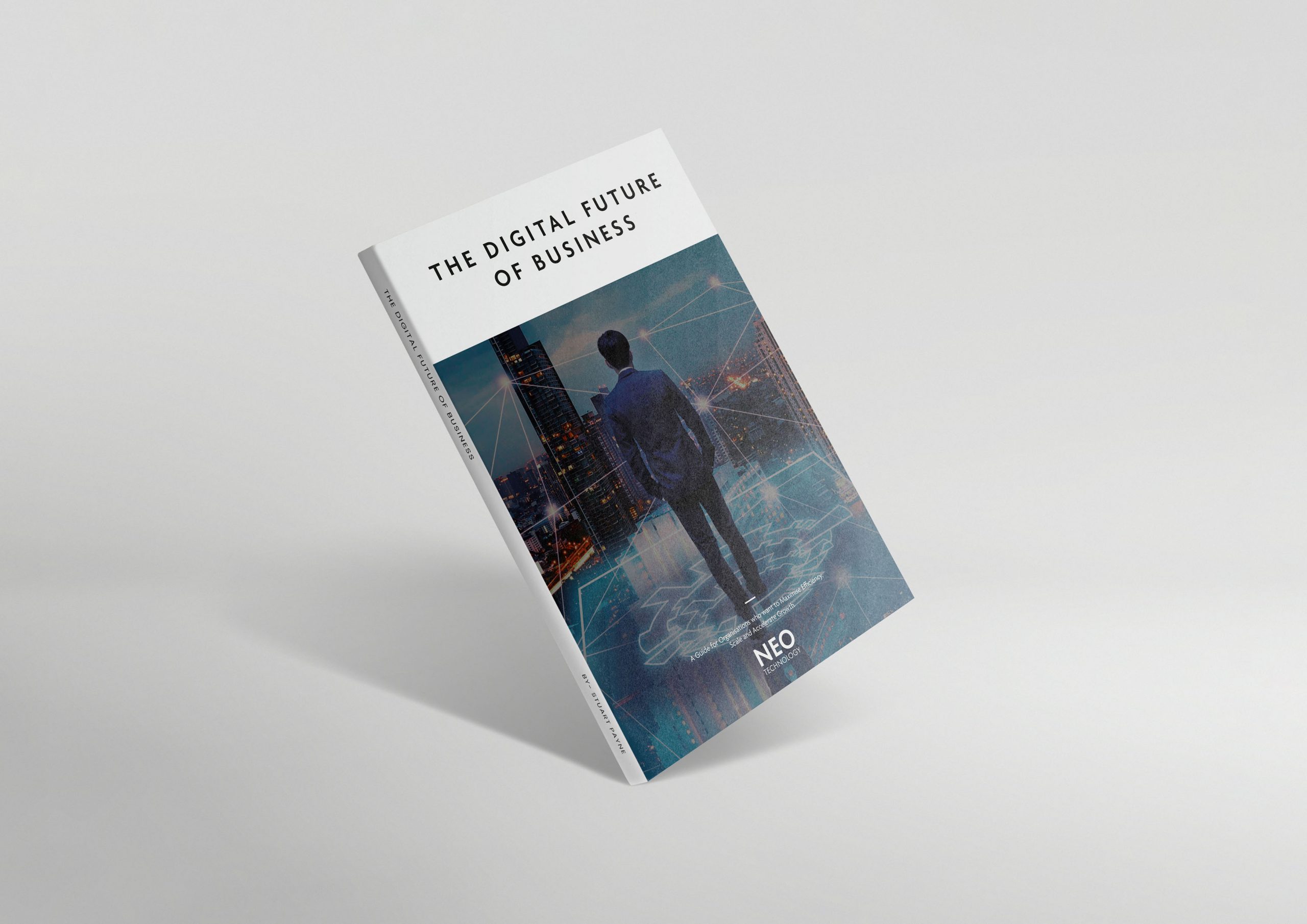The Digital Future of Business
Join our community who have learnt how to deploy technology faster and have been enabled to disrupt their sector to deliver better customer service and growth.
Digital Business Transformation
Digital Business Transformation is the future for successful businesses who want to maximise efficiency, scale at pace and accelerate growth.
Studies show that digital-first companies are 64% more likely to achieve their business goals, and with IoT and AI at their disposal, the business sector is better positioned to adapt to a more versatile, fast-paced approach to doing business.
Despite this, 60% of people surveyed said they lack or are unsure that they have the current business systems, processes, technology, skills and employees necessary to support their much-needed Digital Business Transformation.
Businesses that embrace smart tech and digital strategies will liberate themselves from many repetitive onerous tasks while reducing deployment costs. To succeed, they will need to adjust their work culture into one that welcomes change and tackles the challenges of digitalisation head-on.
In collaboration with their digital partners, organisations must also ensure that employees are not left behind by Digital Business Transformation. All stakeholders must get an equal chance to adapt so that clients and employees benefit from digitalisation.

Current Trends & Emerging Technologies
Which digital technologies offer the greatest potential for your organisation?
‘Digital Business Transformation’ is essential for boosting efficiency, cutting costs, and increasing employee engagement and customer satisfaction.
It takes more than digital technology alone to make a transformation process succeed. Businesses need to know how best to allocate resources with the relevant skills to meet the specific requirements of their customers’ and employees’.
Businesses that undergo this transformation will have more digital technology at their disposal, from big data to technical stacks through to VR and AI.
Some organisations benefit from highly skilled, experienced and dedicated outsourced teams based on a hybrid model of local and offshore working. This agile approach to upscaling and downscaling personnel including time zone crossover delivers fast onboarding timeframes and increased speed of deployment, as well as significant cost savings.
What are the main drivers of Digitalisation in business?
IoT is driving businesses towards complete digitalisation at pace. Magnum Photos benefits from its digital partnership with Neo Technology, who play a pivotal role in developing and deploying AI. Organisations need Digital Business Transformation partners who can interpret their needs, analyse their requirements, and specify the technology that delivers efficiency and scalability as well as a great user experience.
These partners collaborate with companies using workshops with their key stakeholders, listening to their pain points, their priorities, and their long-term goals. These teams conduct a discovery phase to establish your requirements, then they develop software to deliver value at pace. These agile, DevOps experts increase efficiency by automating manual tasks that allow employees within the organisation to do more and achieve significant and transformational results.
Which processes in the value chain can gain the most from digitalisation?
Digital platforms that harness artificial intelligence can strengthen customer engagement. The challenges of customer demand and employee engagement are resolved through a combination of bespoke software, integrations and AI to strike a balance between employee and customer satisfaction as well as revenue.
In the age of hybrid working, cybersecurity is a vital factor, whether it concerns the upkeep of on-premise servers, cloud security and online safeguarding. The use of digital technology to monitor infrastructure ensures a reliable maintenance system while at the same time keeping customers, stakeholders and staff updated.
Lastly, an automated collaboration between businesses and service providers creates new opportunities for digital optimisation.
According to Gartner, organisations that embrace DevOps & Agile Methodologies are more likely to succeed in meeting customer needs than organisations that continue to use traditional management tools
AI is driving companies towards complete digitalisation at pace. The international photography group magnum photos benefits from digital partners at neo technology, who play a pivotal role in developing and deploying ai in the business sector.

Which Process In The Value Chain Can Gain The Most From Digitalisation?
Cloud technology enables employees to work remotely and focus on their objectives while keeping up to date with their customers and service providers by accessing systems globally.
Companies with cloud computing platforms benefit from much lower overheads than traditional companies which means they benefit from cost-savings and better digital security.
Harnessing automation can relieve workers form onerous manual processes.
Digital alternatives such as online applications, payments and communications are 20 times more cost-effective than telephone exchanges and 50 times more cost-effective than face-to-face meetings.
Online processes increase customer satisfaction and business efficiency, because they are not reliant on human intervention.
Integration of platforms and the creation of dashboards allows the analysis of data and decision-making to be made efficiently.
In order to keep data safe and in line with GDPR, businesses utilising cloud technology with in-country servers are more protected from cyber-attacks and hacking.
Internet of Things, whether interconnected devices or smart meters, enable businesses to improve efficiency through connectivity and controlling processes from a centralised location.
IoT can help businesses make informed, data-driven decisions and forecasts to resolve potential issues, as well as minimise costs and disruptions. The use of integrated communication channels significantly benefits both employee and customer engagement.
Did you know 71% of digitally focused organisations say they attract new talent based on their use of data? Naturally, the more data, the more insight there is for businesses to deliver increased quality of service.
Automated advice and customer care line services such as online account information and automated chat systems can meet customer demands 24 hours a day, seven days a week.
One of the advantages of Digital Business Transformation is that customer services become more accessible and reliable. Digitalisation has enabled business leaders to save more time for their employees so that their employees can deliver better front line customer service.
The cost-saving benefit of digitalisation on customer service can be significant. We have seen savings in excess of £1 million from the automation of customer service help desks.
As companies undergo their Digital Business Transformation, the utilisation of artificial intelligence and virtual support mechanisms such as Amazon Alexa will play a pivotal role as they reimagine and reshape their ecosystem. The familiarity and user friendliness of Chat Bots will simplify interactions for customers and stakeholders.
Discover What We Do

Does AI Have An Answer To Everything?
Why are companies increasingly engaging in digital collaborations with their stakeholders, using ‘smart contracts’ and storing them using blockchain technology to improve security?
Smart technology helps to secure systems and keeps users interconnected through digital communities. This can protect remote workers from cybercrime while making services more globally accessible.
Smart devices can even monitor remote workers’ activity to manage productivity and protect company data and collaboration between employees, teams and partners. Automation can be used to attract potential customers and identify their requirements, specific preferences, and intent to buy a product or service.
AI is the game-changer in the evolution of business and the pandemic has accelerated its use to determine the automation of manual tasks. The use of digital workspaces, online learning environments, self-service portals and live streaming for meetings has allowed businesses to adapt in order to thrive.
How well have businesses kept pace with the need for instant answers to all our questions?
Functions like Siri and Amazon Alexa can tell you the weather in an instant, while chatbots and smart sensors can keep clients up to date with information to reduce the number of manual touch points.
Such technology has dominated areas including entertainment, retail businesses. However, they may face more nuanced challenges that cannot always be resolved by internal teams.
They may need to seek the services of more specialist partners to deliver disruptive and dynamic technology.
How can chatbots be made to work for the business sector?
With so many different customers, terms and conditions making a business work can be challenging. Chatbots can be programmed to answer customer-specific queries or more simple questions such as “When is my boiler being replaced?” or “when will my marketing campaign go live?” As we have already stated, we know of instances where people have saved £1 million through the use of chatbots.

AI Is The Great Game-changer In The Evolution Of Mankind, And The Pandemic Has Accelerated This Digital Transition. To Make Use Of Prop Tech, IoT, Chatbots & Self-service Portals, What Do Business Need To Consider?
COMPLEXITY
Make sure your digital solution can handle the specific complexities of your organisation. With the use of APIs, your bot will be able to access the information needed to give tailored and user-specific answers to customers and stakeholders.
EVOLUTION
Chatbots evolve. They will not always get it right, especially when dealing with nuanced problems that require a human touch. Like humans, bots learn and improve using AI as they go along and need to be given a chance to get it right. The success of chatbots is relies on the organisation to develop a humanised approach.
EMPATHY
Chatbots that have been developed with a humanised approach can replicate empathy to communicate and engage with customers and employees.
Chatbots are non-judgmental and reliable, which make them more operationally efficient and can save organisations significant amounts of secondary communications.
NATURE
Make sure to train, or ‘parent’ your chatbot. Depending on the complexity of the communication, based upon the customer interaction, the bot will determine the best nurture campaign for prospects, customers, and employees. Generative chatbots require a large amount of conversational data to reach an adequate level of proficiency.
TRANSPARENCY
If your organisation embarks on a Digital Business Transformation journey, it is paramount that you remain open and transparent with your customers. Bots are there to reduce low-level manual tasks, not replace you. A successful digitalisation programme changes the way we live and work without disregarding the humanised experience.

What Does A Digital Business Transformation Entail & Why Is It Necessary?
Sustainable Digital Transformation For The Future
Digital Business Transformation is about incorporating technology to enhance your organisation’s business performance, increase efficiency & reduce costs. Growing your business is about reimagining and improving your business to stay relevant and thrive.
These technologies can transform a business by reinventing the customer and employee experience, driving growth, increasing productivity, managing risk, improving security, controlling costs, increasing profit and ultimately remaining competitive and economically viable.
By its nature, Digital Transformation can change an organisation’s mindset and culture. It compels businesses to challenge the status quo, experiment with new approaches, be bold and be disruptive in their sector.
Organisations need to protect and responsibly manage user data, particularly sensitive information as well as ensure adherence and compliance to privacy and other global, national and local laws.
The use of machine learning tools can enable an organisation to gather more data and also use the data more effectively to better understand and support the business and its customer needs.
Fundamentally, it’s about having an effective strategy bespoke to your business that uses the technology, tools, processes, skills and solutions needed to keep you up-to-date with market changes and customer demands.
Few organisations remain competitive over the long term without having a strategic plan. 51% of businesses say they do not have the current business systems, technology, skills and employees that reflect the change they need to stay relevant and get ahead. Businesses will need to invest more heavily in in meeting their customers’ needs.
Businesses will need to invest more heavily in technology to stay efficient and competitive in meeting their customers’ needs.
What is your long-term strategy?
Many organisations don’t take time at the outset to define what success looks like. A successful Digital Business Transformation strategy will be uniquely tailored to the business’ requirements and its long-term ambitions. When acquiring digital business solutions, it is necessary to understand the existing business environment and the software architecture.
Successful digitalisation is driven by a workforce with the appropriate technology, skills and resources. Successful implementation isn’t about the technology, but who uses it and the CX.
At times there may be a skills gap and an employee shortage that can mean the need to partner with managed service provider with a broader skill-set.
They can help with scaling up and provide support and training for existing employees to develop and retain new skills. Employees must be supported whether through training, partnering with experienced technology vendors or introducing peer sup-port to ensure they have the capabilities, skill sets, confidence and motivation needed to enable and support the change introduced.
What does the future organisation look like?
Over the last 18 months, the pandemic has accelerated Digital Transformation in a variety of ways – the use of digital workspaces, live streaming for meetings and events, self service portals and remote working have been more important than ever to allow businesses to adapt, survive and even thrive, despite unexpected challenges. This has been a key driver of Digital Business Transformation initiatives.
Customers and employees spend an increasing amount of time on multiple devices, for both work and leisure. This has has also accelerated during the pandemic. Companies need solutions that enable employees to access the same systems and shared experiences as they can in the workplace. The user experience on mobile platforms in multiple channels also increases employee and customer satisfaction, improves efficiency, increases productivity and growth.
Successful Digital Transformation Must Be Strategy-led. Whilst It Begins With A Vision Of What Change Will Look Like, The Projects That Result From That Vision Must Closely Align To The Business' With Goals & Objectives.

Getting Real With Digitalisation
As businesses modernise their digital services, what are the benefits of implementing real-time technology into customer self-service?
When customers place an order online, they expect to be able to decide when their order arrives, who delivers it and even the location of the delivery driver. If something goes wrong, they expect to know why and how the problem is being resolved in near real-time.
Real-time technology has raised the bar for customer service expectations and the marketplace is constantly changing and evolving, sometimes rapidly and unexpectedly as we’ve experienced with the pandemic.
To stay competitive, businesses must be able to change, innovate, keep up with digital trends and adopt new technologies where appropriate. The use of outdated, non-integrated legacy systems has held many businesses back in terms of innovative efficiency.
Websites, apps, and even portal-based interactions are amongst the channels that can be used for a successful Digital Business Transformation.
Real-time booking systems enable customers to cut out the middleman and arrange for services through direct online processes. Whether the problem was a late delivery or a broken-down car, customers would be able to provide verbal and photographic evidence to a chatbot which would assess the issue and offer the customer a range of options and solutions.
A constant flow of data enables businesses to review and improve their services and capabilities on an ongoing basis.
Data Streaming is the New Normal
Digital mediums keep businesses in touch with their clients, while mobile devices give organisations real-time access to the information and systems needed in order to complete tasks. With these automated processes in place, business departments can save themselves from time-consuming manual processes, reduce the risk of duplicating administrative tasks, and avoid delayed responses to customer requirements. With information available online, businesses will be empowered to collect and leverage data regarding their customers and employees and make better-informed decisions.
Digitalisation will increase Proactivity
Many businesses are prone to taking a reactive approach to maintenance and customer queries, responding to problems only after they have occurred. This can lead to frustrating delays for stakeholders, putting businesses at risk of increased costs, time consuming tasks and reputational damage. Earlier, preventative interventions can prevent such problems from occurring in the first place, saving time and reducing costs. Data from inbuilt IoT systems can flag potential maintenance issues, ensuring better system management and upkeep. Big data and analytics can help providers identify irregularities and patterns regarding their customers and employees.
Agility in IT
One of the biggest challenges of Digital Business Transformation is replacing legacy IT infrastructure. Successful digitalisation requires a strong, secure, updated and flexible infrastructure that can handle large amounts of data in real-time, and that can be relied upon to safeguard your organisation’s digital applications as well as your data.
Digital-first businesses need agile IT environments that harness cloud technology to provide unlimited storage capacity on demand and an adaptable network environment.

Why Do We Need Digital Inclusion?
The digital skills gap limits the ability of many in our society to manage information, communicate, transact, problem-solve or create via digital channels. How do we make digital transformation accessible for all?
The pandemic has accelerated what would otherwise have been a gradual, natural migration towards a more digital orientated way of life, and this has led organisations into a situation where there is a lack of skill and that has been compounded by a lack of resource.
The digital skills gap limits the ability of businesses to implement increased employee and customer satisfaction. Did you know that 22% of people in the UK lack the necessary digital skills for the working environment, while 82% of jobs require digital skills? A failure to recognise these disparities risks leaving businesses and workers behind.
The impact on short, medium and long-term goals can be minimised by outsourcing to increase resources and the required digital skills. People have largely embraced the advantages of digital technology such as apps, online ordering and digital payments on multiple devices. Did you know, that the majority of B2B buyers use more than three devices in their working day?
The elderly, by contrast, are often put to a disadvantage by digitalisation and our increasingly cashless society. The need for great UI and CX is vital to maximise engagement. Digitalisation is about giving customers more choice and control over the way they interact to increase customer engagement and satisfaction.
Digitalisation saves significant amounts of time and cost for service providers. Businesses that want to embrace Digitalisation must take an integrated and pragmatic approach to create technology solutions with great usability.
Technological innovation coupled with the pandemic has pushed many out of their comfort zone. How can digitalisation help elderly and vulnerable stakeholders, rather than burden them? Innovative, voice automated appliances can help customers with limited sight, hearing and mobility.
These IoT devices can connect them with service providers, friends, relatives and you. Technological innovation does not have to be a challenge for those less accustomed to digitalisation. It can o er business-enhancing opportunities for your organisation.
It is the responsibility of your business to deploy software and make services equally accessible and beneficial for every customer, irrespective of their skills and abilities.


